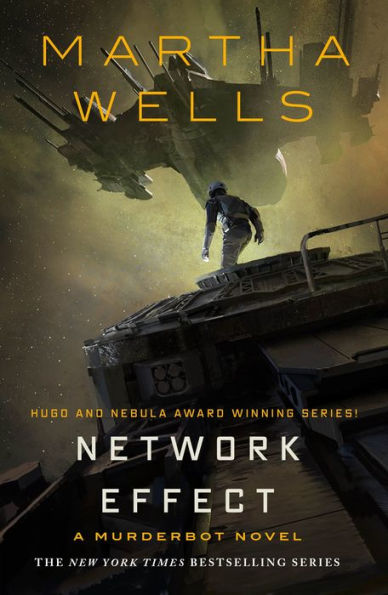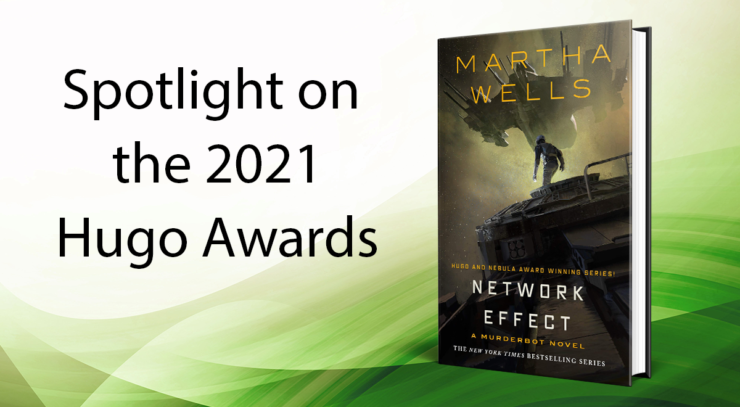In the lead-up to the 2021 Hugo Awards, we’re taking time to appreciate this year’s best novel Finalists, and what makes each of them great.
This is Murderbot’s time. I was thinking about it in spring 2020 when Network Effect first came out, as many of us had to adjust to a life in quarantine, with hours and hours that needed to be filled in a way that would distract us from the horrors out in the world, while also hopefully nourishing some deep part of ourselves, that Murderbot was maybe our best model of behavior.
And the more I think about it the more I agree with myself.
Note: This post contains spoilers.
The media in the Murderbot Diaries is not presented as an escape. It’s not an addiction, it’s not a way for Murderbot to “learn to be human”—a thing it does not want—it’s not a balm, it’s not the opiate of the masses, and there is no distinction that I caught between “high” and “low” brow media. The serials and the plays are expressions of consciousness and self—and as such become an intrinsic part of Murderbot’s sense of who it is. Wells shows this in the first book of the series, All Systems Red, when Murderbot uses its media as a way to “person”—“I was also planning to use the time to watch some Sanctuary Moon and recharge my ability to cope with humans at close quarters without losing my mind”—and again in an elegant moment in Exit Strategy, when Murderbot nearly dies saving Dr. Mensah, and only truly begins to put itself back together once its accessed its media files: “What the hell was this? The Rise and Fall of Sanctuary Moon? I started to review it. And boom, hundreds of thousands of connections blossomed. I had control over my processes again and initiated a diagnostic and data repair sequence. Memories started to sort and order at a higher rate.”
Murderbot and ART become friends through sharing media. Not because one has to explain to the other how humans act or any of that, but because they both like it, and it becomes a shared language for them. Murderbot gets a sense of who ART is, and how it feels to be a ship, by watching how it responds to different episodes of WorldHoppers. They begin to trust each other because of the show, and when ART needs Murderbot’s help in Network Effect, it uses Worldhoppers as a code, knowing that Murderbot will understand what it’s asking.
Buy the Book


Network Effect
Later on, the media that Murderbot has handed down to Murderbot 2.0 is crucial in helping it retain a sense of self as something more than killware. Murderbot 1.0 and ART understand that the media packet has to be a core part of what they pass down to their “child.” Likewise, it’s part of Murderbot’s overture to Three. Again, the fiction that all of them consume is part of their selves, and they are not fully themselves without it.
What has “media” been this year other than a lifeline? Or a life jacket? Or a whole-ass lifeboat? It’s not frivolous or escapist, and it’s not teaching us to be human or reminding us to be human—for many people this year it was literally how we remembered we weren’t alone. It’s been a way to give our brains a jolt of normalcy. I think the reason there was an uptick in people watching Fast & Furious movies was literally the series’ core tenet of family. The uptick in Columbo rewatches was because it was nice to see a solid working-class guy with an impeccable moral compass make sense out of chaos and death. People did giant rewatches or first watches of the MCU movies because, yes, they had time, but also because that provides an entire alternate world, with better tech than ours and heroes who help rebuild society after each new catastrophe. We’re living through our own long, drawn-out, soul-crushing Blip.
An important thing to remember, I think, is that the way things are now IS the anomaly. The blip in history. For the vast majority of what we consider human civilization, most humans have been commodity. Most countries were founded on blood, slavery has always existed, sex work has almost always been horrifically exploitative, women have only occasionally been considered human, children have only occasionally been considered human, the upper classes have always squeezed every drop of labor from the lower classes, any race other than the dominant one was always fucked. The idea that every human is born with rights, that they should get to live an autonomous, self-determined life and get a shot at that nebulous thing called happiness, is very new, and even now only accepted in a few discrete places on Earth. I’m lucky enough to live in a specific city, in a specific part of a specific country, and that is why I’m a human. I’m a human because most of the people I encounter every day consider me one. (This wasn’t always the case—I lived for years in a place where I was not guaranteed to be human in other peoples’ eyes. [And again, let me be clear, I’m white. It would’ve been way worse if I wasn’t.] If enough people decide I’m not a human again, I won’t be. I mean, I will be in my own head, which is nice as far as it goes, but I won’t be able to live my life in the world as a human.) The future Wells has created, in which nearly everyone is in a constant state of flux between “person” and “potential exploitable resource”, is really just a full return to normal. And sure that’s a bleak way of looking at it, but I also think it’s important to acknowledge that in order to understand just how fantastic the Murderbot series is, and I would argue, Network Effect in particular.
As the world more and more wrestles with the economic and moral choices that have brought us to this point, I see the argument dealt with more elegantly in the Murderbot books than anywhere else. Wells gives us a few different economic systems. Corporation Rim is capitalism reaching its final form: its super saiyyan, its Golduck, its Capitalaga. Everything is commodity: humans can be indentured for generations, every action has to be bonded, negotiated, invoiced, and paid for. Humans under this system are regarded only slightly better than the SecUnits, who are only a half-step above bots, who are maybe a quarter step above, say, go-carts. Sentience is irrelevant, and empathy is a bug, not a feature.
The Corporation Rim seems to be the largest system. Set against it is The Preservation, a society built from a loose coalition of colonies who use the barter system, and have somehow been able to keep the Corporation Rim at bay. Preservation keeps a fund of currency in order to deal with Corporation Rim, and seemingly can accept people as refugees—but it also seems that people who have grown up in Corporation Rim are so accustomed to that life that most can’t even question it. For questions we get the Pansystem University of Mihira and New Tideland, represented by ART and its crew, which turns out to be a guerrilla movement trying to disrupt Corporation Rim from within. So that’s the economic system—one that respects individual humans but still has various paternalistic laws in place for SecUnits and bots, who have to live under a guardianship, one that regards humans, bots, SecUnits, and, I don’t know, toasters, as all the same level, and only care how much profit they can ring out of them, and the guerrilla faction that floats between them who we’re only just starting to get a sense of.
But what Wells has done that I think is monstrously important is that she hasn’t even set these three against each other—she’s set media against all of them. In Wells’ all-too-familiar future, Murderbot’s love for media is a constant, subtle reminder that there are people creating art and telling stories even in this hyper-privatized world—and telling them just to tell them! Sure, we can assume that the people making popular serials are well-paid for their work, just like our own mainstream actors and showrunners, but what about the people putting on play after play on Preservation Aux? Or the people playing music in almost every corner of the festival? And not to oversell this, but Wells makes the point that art literally saves lives—ART’s life, in fact. We’re living in a time when human worth has a very calculable number attached to it. Art is seen as either frivolous, or a thing to be non-fungibly hoarded. I love that Martha Wells has given us a media-loving murderbot to remind us that personhood and creativity are more important than any political system or financial gain.










